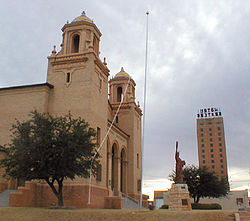Big Spring, Texas
| Big Spring, Texas | |
|---|---|
| City | |

The Municipal Auditorium in Big Spring
|
|
| Nickname(s): "The Spring City" | |
| Coordinates: 32°14′36″N 101°28′31″W / 32.24333°N 101.47528°WCoordinates: 32°14′36″N 101°28′31″W / 32.24333°N 101.47528°W | |
| Country | United States |
| State | Texas |
| County | Howard |
| Government | |
| • Type | Council-Manager |
| • City Council |
Mayor Larry McLellan Raul Marquez Jr. Carmen Harbour Justin Myers Steve Waggoner Raul Benevidas Jim DePauw |
| • City Manager | Todd Darden |
| Area | |
| • Total | 19.2 sq mi (49.7 km2) |
| • Land | 19.1 sq mi (49.5 km2) |
| • Water | 0.1 sq mi (0.2 km2) |
| Elevation | 2,441 ft (744 m) |
| Population (2010) | |
| • Total | 27,291 |
| • Density | 1,320/sq mi (509.8/km2) |
| United States Census Bureau | |
| Time zone | CST (UTC−6) |
| • Summer (DST) | CDT (UTC−6) |
| ZIP codes | 79720-79721 |
| Area code | 432 |
| FIPS code | 48-08236 |
| GNIS feature ID | 1330654 |
| Website | myBigSpring.com |
Big Spring is a city in and the county seat of Howard County, Texas, United States, at the crossroads of U.S. Highway 87 and Interstate 20. With a population of 27,291 at the 2010 census, it is the largest city between Midland to the west, Abilene to the east, Lubbock to the north, and San Angelo to the south. Big Spring was established as the county seat of Howard County in 1882; it is the largest community in the county.
The city got its name from the single, large spring that issued into a small gorge between the base of Scenic Mountain and a neighboring hill in the southwestern part of the city limits. Although the name is sometimes still mistakenly pluralized, it is officially singular. "To the native or established residents who may wince at the plural in Big Spring, it should be explained that until about 1916, when for some unexplained reason the name dropped the final 's', the official name of the town was indeed Big Springs." There is also a small community named Big Springs, Texas, located in Rusk County in East Texas.
Although the area had long been a popular watering hole for Native Americans and other prehistoric residents and nomads, including members of the more recently established Jumano, Apache, and Comanche tribes, the first European to view the site now known as Big Spring was probably a member of a Spanish expedition, possibly that of Álvar Núñez Cabeza de Vaca, although the record of his travels cannot confirm his visit.
United States Army Captain Randolph B. Marcy's expedition was the first United States expedition to explore and map the area in 1849.Marcy marked the spring as a campsite on the Overland Trail to California. The site began to collect inhabitants and by the late 1870s, a settlement had sprung up to support buffalo hunters who frequented the area. The original settlement consisted largely of hide huts and saloons. Ranching quickly became a major industry in the area; early ranchers included F.G. Oxsheer, C.C. Slaughter, and B.F. Wolcott.
...
Wikipedia

